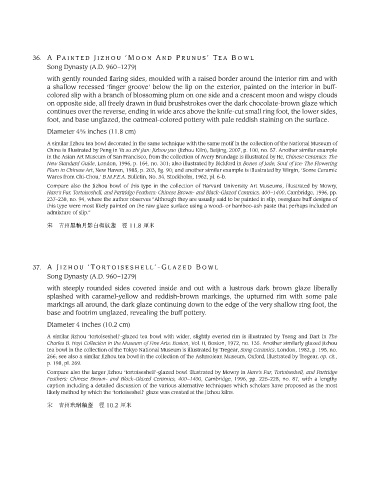Page 71 - Longsdorf Collection of Song Ceramics, 2013, J.J. Lally, New York
P. 71
36. A P ainted Jizhou ‘Moon And Prunus’ Tea Bowl
Song Dynasty (A.D. 960–1279)
with gently rounded flaring sides, moulded with a raised border around the interior rim and with
a shallow recessed ‘finger groove’ below the lip on the exterior, painted on the interior in buff-
colored slip with a branch of blossoming plum on one side and a crescent moon and wispy clouds
on opposite side, all freely drawn in fluid brushstrokes over the dark chocolate-brown glaze which
continues over the reverse, ending in wide arcs above the knife-cut small ring foot, the lower sides,
foot, and base unglazed, the oatmeal-colored pottery with pale reddish staining on the surface.
Diameter 4 ⁄8 inches (11.8 cm)
5
A similar Jizhou tea bowl decorated in the same technique with the same motif in the collection of the National Museum of
China is illustrated by Peng in Ya su zhi jian: Jizhou yao (Jizhou Kiln), Beijing, 2007, p. 100, no. 57. Another similar example
in the Asian Art Museum of San Francisco, from the collection of Avery Brundage is illustrated by He, Chinese Ceramics: The
New Standard Guide, London, 1996, p. 164, no. 301; also illustrated by Bickford in Bones of Jade, Soul of Ice: The Flowering
Plum in Chinese Art, New Haven, 1985, p. 203, fig. 90; and another similar example is illustrated by Wirgin, ‘Some Ceramic
Wares from Chi-Chou,’ B.M.F.E.A. Bulletin, No. 34, Stockholm, 1962, pl. 6-b.
Compare also the Jizhou bowl of this type in the collection of Harvard University Art Museums, illustrated by Mowry,
Hare’s Fur, Tortoiseshell, and Partridge Feathers: Chinese Brown- and Black-Glazed Ceramics, 400–1400, Cambridge, 1996, pp.
237–238, no. 94, where the author observes “Although they are usually said to be painted in slip, overglaze buff designs of
this type were most likely painted on the raw glaze surface using a wood- or bamboo-ash paste that perhaps included an
admixture of slip.”
宋 吉州黑釉月影白梅紋盞 徑 11.8 厘米
37. A Jizhou ‘Tortoiseshell’-Glazed Bowl
Song Dynasty (A.D. 960–1279)
with steeply rounded sides covered inside and out with a lustrous dark brown glaze liberally
splashed with caramel-yellow and reddish-brown markings, the upturned rim with some pale
markings all around, the dark glaze continuing down to the edge of the very shallow ring foot, the
base and footrim unglazed, revealing the buff pottery.
Diameter 4 inches (10.2 cm)
A similar Jizhou ‘tortoiseshell’-glazed tea bowl with wider, slightly everted rim is illustrated by Tseng and Dart in The
Charles B. Hoyt Collection in the Museum of Fine Arts: Boston, Vol. II, Boston, 1972, no. 135. Another similarly glazed Jizhou
tea bowl in the collection of the Tokyo National Museum is illustrated by Tregear, Song Ceramics, London, 1982, p. 195, no.
266; see also a similar Jizhou tea bowl in the collection of the Ashmolean Museum, Oxford, illustrated by Tregear, op. cit.,
p. 198, pl. 269.
Compare also the larger Jizhou ‘tortoiseshell’-glazed bowl illustrated by Mowry in Hare’s Fur, Tortoiseshell, and Partridge
Feathers: Chinese Brown- and Black-Glazed Ceramics, 400–1400, Cambridge, 1996, pp. 225–228, no. 87, with a lengthy
caption including a detailed discussion of the various alternative techniques which scholars have proposed as the most
likely method by which the ‘tortoiseshell’ glaze was created at the Jizhou kilns.
宋 吉州玳瑁釉盞 徑 10.2 厘米

